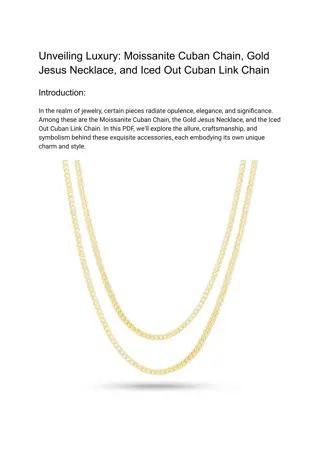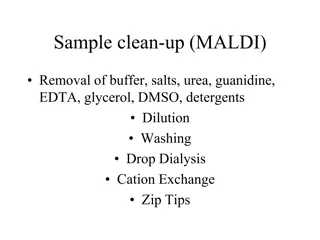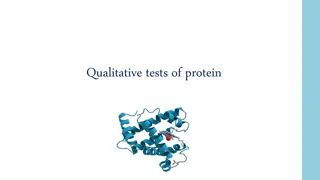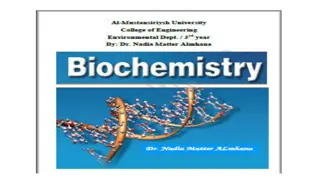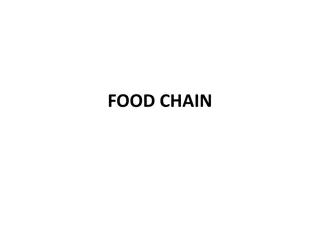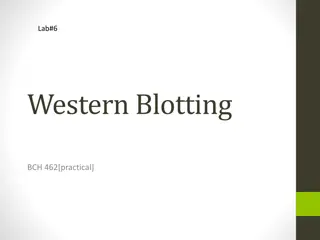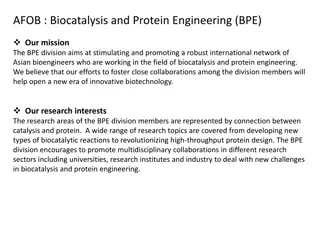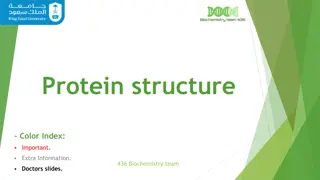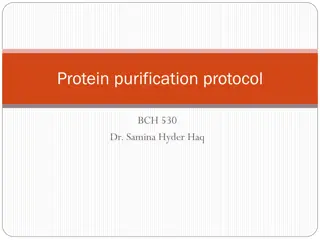Understanding Peptide and Protein Chains Formation
Proteins and peptides are composed of 20 common amino acids linked together through peptide bonds. Chains with less than 50 amino acids are known as peptides, while those exceeding 50 are considered proteins.
Download Presentation

Please find below an Image/Link to download the presentation.
The content on the website is provided AS IS for your information and personal use only. It may not be sold, licensed, or shared on other websites without obtaining consent from the author. Download presentation by click this link. If you encounter any issues during the download, it is possible that the publisher has removed the file from their server.
E N D
Presentation Transcript
Peptides and Proteins 20 amino acids are commonly found in protein. These 20 amino acids are linked together through peptide bond forming peptides and proteins The chains containing less than 50 amino acids are called peptides , while those containing greater than 50 amino acids are called proteins .
Peptide bond formation: -carboxyl group of one amino acid (with side chain R1) forms a covalent peptide bond with -amino group of another amino acid ( with the side chain R2) by removal of a molecule of water. The result is : Dipeptide ( i.e. Two amino acids linked by one peptide bond). By the same way, the dipeptide can then forms a second peptide bond with a third amino acid (with side chain R3) to give Tripeptide. Repetition of this process generates a polypeptide or protein of specific amino acid sequence.
Peptide bond formation: - Each polypeptide chain starts on the left side by free amino group of the first amino acid enter in chain formation . It is termed (N- terminus). - Each polypeptide chain ends on the right side by free COOH group of the last amino acid and termed (C-terminus). Fullname:Alanyltyrosylaspartylglycine
Examples on Peptides: 1- Dipeptide (two amino acids joined by one peptide bond): Example: Aspartame which acts as sweetening agent being used in replacement of cane sugar. It is composed of aspartic acid and phenyl alanine. 2-Tripeptides (3 amino acids linked by two peptide bonds). Example: GSH which is formed from 3 amino acids: glutamic acid, cysteine and glycine. It helps in protects against free radical which causes cell damage.
3- octapeptides: (8 amino acids) Examples: Two hormones; oxytocine and vasopressin (ADH). 4- Oligopeptide: short polymer of residues linked by peptide bonds; up to10-20 residues. 5- polypeptides: longer polymer of residues linked by peptide bonds; larger sizes. 6- Protein: one or more polypeptide chains
Notes: Residue an amino acid (or peptide unit) in an oligopeptide, polypeptide or protein Biological polymers are associated with biological function Proteins
Identification of N-terminal Residue (a) N-terminal residue can be identified by using a reagent that bond covalently with its -NH2 group. Because the bond is stable to hot acid hydrolysis, the derivative of the N-terminal residue can be identified by chromatographic procedures after the protein has been hydrolysed. Two reagents are commonly used
1- Sangers reagent: The reagent contains 1-fluoro-2,4- dinitrobenzene (FDNB). It reacts with free NH2 group in an alkaline medium.
The compound so formed can be isolated after protein hydrolysis and identified. Sanger was first to sequence a polypeptide. He determined the complete primary structure of the hormone insulin.
2. Reaction with Dansyl Chloride: The N- terminal NH2 group can also combine with Dansyl chloride(1-dimethyl aminonaphthalene-5- sulphonyl chloride) to form a fluorescent dansyl derivative which can be isolated and identified.
(b) Edman reaction: A similar reaction with NH2 groupc an occur with the reagent phenyl isothiocyanate and identification of the N-terminal amino acid. thus enables the
Sequenator Edman and G. Begg have perfected an automated amino acid sequenator for carrying out sequential degradation of peptides by the phenylisothiocyanate procedure (Edman s reaction).Automated amino acid sequencers now widely used, which permit very rapid determination of the amino acid sequences of polypeptides upto 100 amino acid approximately. Amino acids are determined sequentially from N- terminal end. The phenyl thiohydantoin amino acid liberated is identified liquidchromatography (HPLC). by high performance
Proteins Proteins are the most abundant molecules in living cells, constituting 40% - 70% of their dry weight. Proteins are built from amino acid monomers. Typical protein functions: 1-Catalyze Reactions (enzymes). 2-Chemical Signaling (hormones). 3-Storage (e.g. myoglobin stores oxygen). 4-Structural (e.g. collagen in skin and tendons). 5-Protective (e.g. antibodies). 6-Contractile (e.g. myosin in muscle). 7-Transport (e.g. hemoglobin.
Protein structure: There are four levels of protein structure (primary, secondary, tertiary and quaternary) 1-Primary structure: - The primary structure of a protein is its unique sequence of amino acids - At one end is an amino acid with a free amino group the (the N-terminus) and at the other is an amino acid with a free carboxyl group the (the C-terminus).
2- Secondary structure: Results from hydrogen bond formation between hydrogen of NH group of peptide bond and the carbonyl oxygen of another peptide bond. According to H-bonding there are two main forms of secondary structure: -helix: It is a spiral structure resulting from hydrogen bonding between one peptide bond and the fourth one -sheets: is another form of secondary structure in which two or more polypeptides (or segments of the same peptide chain) are linked together by hydrogen bond between H- of NH- of one chain and carbonyl oxygen of adjacent chain (or segment).
3-Tertiary structure: Tertiary: chain folding: fibrous and globular. Chain folding causes changes in physical properties and biological function. Fibrous proteins tend to have length >> diameter, tend to be water insoluble. Globular proteins have spherical shape. Contributing factors are the hydrophobic effects, hydrogen bonding, ionic bond, and disulfide linkages by cysteine units.
Some systems exist as larger "assemblies" several polypeptide chains. Quaternary structures are held together by a variety of interactions including hydrogen bonding, Van der Waals interactions, ionic bonding and occasionally disulfide bonds. Ex: Collagen is a fibrous protein of three polypeptides (trimeric), Hemoglobin polypeptide is a globular protein with four polypeptide chains (tetrameric) Insulin : two chains (dimeric).





